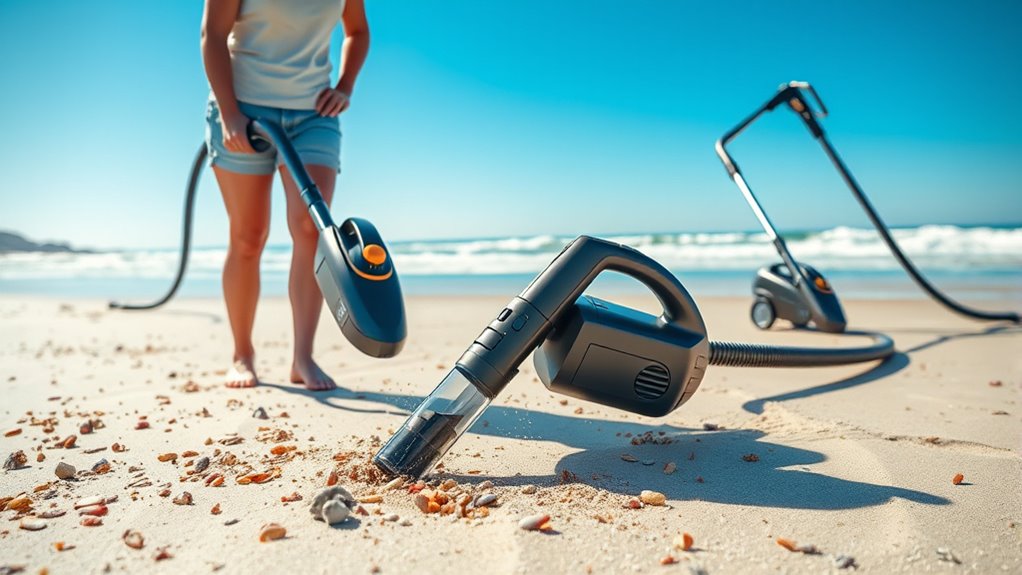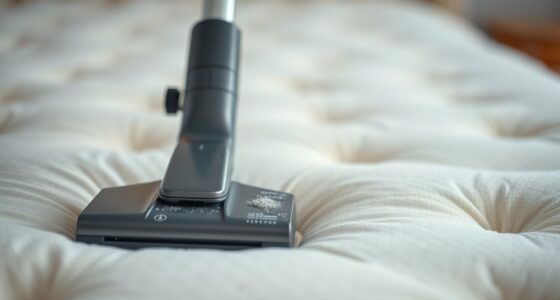After a beach day, use a vacuum with strong airflow, wide nozzles, and adjustable settings for sand removal from clothes, shoes, and your car interior. Start by shaking and brushing off items, then vacuum slowly with overlapping passes to prevent sand from spreading. Keep filters and seals clean, and use attachments like crevice tools or upholstery brushes for deep cleaning. For more tips on efficient cleanup and maintenance, continue exploring these effective vacuum strategies.
Key Takeaways
- Choose vacuums with strong airflow, adjustable settings, and HEPA filters for effective fine sand removal.
- Regularly maintain filters, seals, and brush rolls to sustain optimal suction and prevent clogging.
- Use slow, overlapping passes and low brush height to contain sand and minimize dispersion.
- Utilize appropriate attachments like crevice tools and upholstery brushes for targeted cleaning.
- Seal off adjacent areas during vacuuming to prevent sand from spreading and ensure thorough cleanup.
Choosing the Right Vacuum for Sand Removal
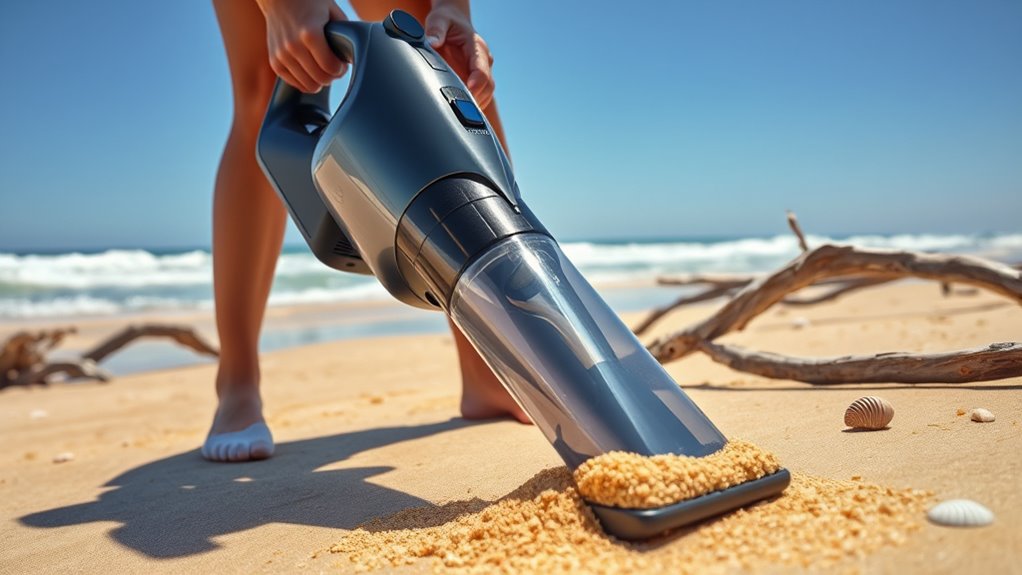
When it comes to cleaning sand effectively, choosing the right vacuum is essential. You need a vacuum with advanced vacuum technology that can handle fine particles without clogging or losing suction. Look for models with strong airflow and a wide nozzle, designed specifically for loose debris like sand. An ergonomic design is equally important, as it ensures comfortable use during extended cleanup sessions. A lightweight, well-balanced vacuum reduces strain on your arm and wrist, making the process smoother. Consider vacuums with adjustable settings to optimize performance based on the sand’s texture and location. By selecting a device that combines effective vacuum technology with ergonomic features, you’ll make your beach cleanup faster, easier, and less tiring. Additionally, choosing a vacuum with a powerful motor ensures consistent suction even with challenging debris like sand.
Preparing Your Vacuum for Effective Sand Cleanup
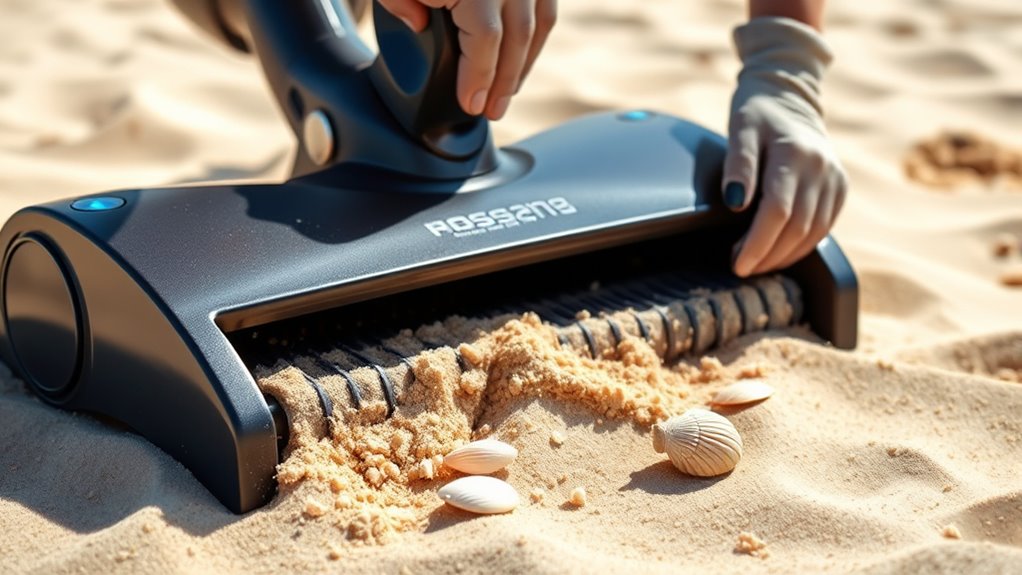
Before you start cleaning, make sure your vacuum’s filter is in good shape and not clogged. Adjust the suction power to a level that lifts sand effectively without damaging your surfaces. Taking these steps guarantees your vacuum works efficiently and prevents unnecessary wear. For optimal results, consider using a vacuum designed for fine debris, which can handle sand without clogging or damaging your equipment.
Check Filter Integrity
Have you checked your vacuum’s filter lately to guarantee it’s in good condition? Regular filter inspection is essential for effective sand cleanup. A damaged or clogged filter hampers suction and can damage the motor. Verify the seal integrity is intact to prevent dust and sand from bypassing the filter, reducing efficiency. To help you assess, here’s a quick overview:
| Filter Condition | Seal Integrity | Action Needed |
|---|---|---|
| Clean & intact | No leaks | Continue use |
| Dirty or damaged | Leaks present | Replace or repair filter |
| Proper seal | No leaks | Good to go |
| Worn seal | Leaks possible | Seal or replace seal |
Adjust Suction Power
Adjusting your vacuum’s suction power is essential for effectively cleaning sand without causing damage or losing efficiency. Proper suction adjustment ensures you remove sand thoroughly while protecting delicate surfaces. To achieve the right vacuum calibration, start by testing different suction levels. Use a lower setting for sensitive carpets or lightweight surfaces and increase it for stubborn sand on sturdy flooring. Keep an eye on the airflow and listen for any irregular sounds that might indicate over-suction. Regularly fine-tune your vacuum’s suction adjustment during cleanup to prevent clogging or suction loss. Remember, ideal vacuum calibration maximizes cleaning power and extends your vacuum’s lifespan. By mastering suction adjustment, you’ll make sand cleanup faster, easier, and more effective. Additionally, understanding the importance of filter maintenance helps ensure your vacuum continues to perform optimally during and after cleanup.
Techniques for Vacuuming Clothes and Beach Towels
To effectively remove sand from your clothes and beach towels, start with lint rollers to pick up surface debris. For stubborn grains, use a damp sponge to gently lift the sand without damaging the fabric. Shaking and beating your items outside can also help loosen remaining particles before vacuuming.
Use Lint Rollers
Using a lint roller is one of the quickest and easiest ways to remove sand and debris from your clothes and beach towels. Simply roll it over the fabric, and the sticky sheets will pick up particles effortlessly. Keep a lint roller handy in your beach bag for quick touch-ups before heading home or to your car. It’s especially effective for delicate fabrics that can’t withstand vigorous vacuuming. To get the best results, press gently and overlap your strokes. Replace the sticky sheets when they’re full to maintain maximum adhesion. You can also use it on accessories like hats and swimsuits. It’s a simple, no-mess solution to keep your clothing sand-free and fresh after a long day at the beach especially compared to more complex vacuuming methods.
Employ Wet Sponges
Employing wet sponges can be an effective way to vacuum sand from your clothes and beach towels without damaging delicate fabrics. Dampen a soft sponge slightly and gently press it onto the sand-blotted areas. The wet sponge lifts the sand without rubbing it in further or causing damage. Use light, patting motions to gather and remove sand particles efficiently. This method works well on lightweight fabrics and textured towels, preventing the mess from spreading or embedding deeper. Keep a small container of water nearby for quick re-dipping. Here’s a quick guide:
| Technique | Benefits |
|---|---|
| Wet sponge use | Gentle, effective sand removal |
| Sand blotting | Prevents sand from spreading |
Being aware of the weight of your beach equipment can also help you handle cleanup more efficiently and avoid strain during transport. This simple approach helps you clean your clothes and towels quickly and safely after a beach day.
Shake and Beat
Sometimes, the simplest way to remove sand from your clothes and beach towels is by giving them a good shake and beat. Manual removal through shaking and beating dislodges stubborn sand particles without the need for a vacuum. This method is quick, effective, and gentle on fabrics. Hold your towel or clothes firmly and give them a vigorous shake to loosen loose sand. For more stubborn particles, gently beat the fabric with a soft object or your hand to dislodge remaining grains. This technique works best outdoors, where gravity helps the sand fall away, reducing the need for vacuuming. Remember, shaking and beating are excellent pre-vacuum steps, saving time and effort while keeping your fabrics sand-free. Incorporating proper technique can further enhance sand removal efficiency and protect your fabrics from damage.
- Use a sturdy surface to beat your towels safely
- Shake clothes vigorously to dislodge loose sand
- Focus on seams and textured areas for manual removal
- Avoid beating too hard to prevent fabric damage
Best Practices for Vacuuming Car Seats and Interior
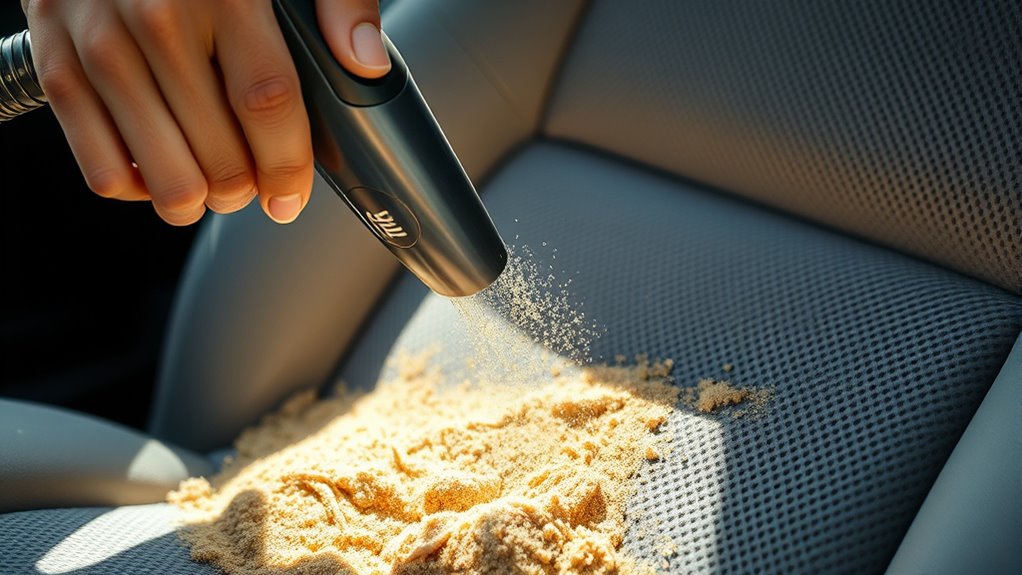
To effectively vacuum your car seats and interior, start by removing any loose debris or larger items to give your vacuum a clear path to dirt and dust. Next, check your vacuum’s filter and verify it’s clean; a clogged filter reduces suction power. Adjust the suction setting based on your car’s upholstery—higher for carpets, lower for delicate fabric seats. Use the appropriate attachment, like a crevice tool or brush, to reach tight corners and fabric fibers. Make slow, deliberate passes to loosen embedded sand and dust. Regularly clean or replace the vacuum filter to maintain peak performance. Incorporating powerful persuasive words into your cleaning routine can motivate consistent upkeep and ensure thorough results. By following these practices, you’ll maximize your vacuum’s efficiency and leave your car interior thoroughly clean after beach days.
Tips for Vacuuming Sand From Shoes and Footwear
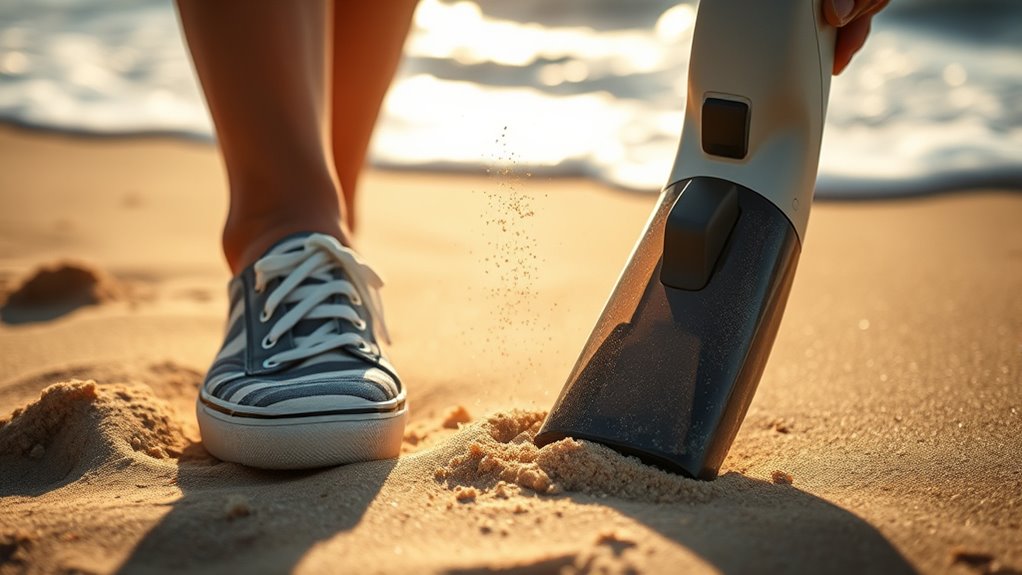
Sand can quickly cling to the soles and treads of your shoes, making it tricky to keep your footwear clean after a day at the beach. To effectively sand removal from beach footwear, use your vacuum with a brush attachment to loosen stubborn particles. Before vacuuming, tap your shoes gently to dislodge loose sand. For best results, focus on the treads and sides where sand tends to hide. Consider using a handheld vacuum for small, tight spots, and always check the suction settings to avoid damaging delicate materials. Keep a small brush or cloth handy for quick dust-offs between vacuum sessions. Proper sand removal helps prolong your footwear’s lifespan and keeps your home sand-free. Additionally, understanding the importance of fatherhood and the bonds we cherish reminds us to take care of our belongings with love and attention.
Using Attachments and Accessories for Deep Cleaning
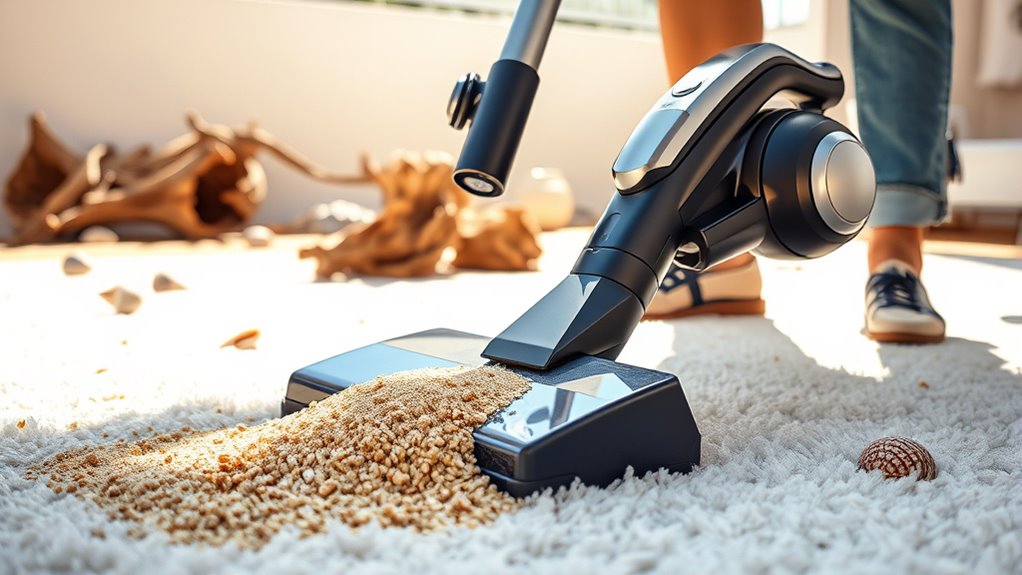
Using attachments and accessories effectively can considerably enhance your deep cleaning efforts after a day at the beach. Specialized accessories like crevice tools and upholstery brushes target hard-to-reach areas and delicate surfaces, ensuring thorough removal of residual sand. Vacuum attachments help loosen and lift embedded particles from carpets, furniture, and tight corners. To choose the right tools, consider the surface you’re cleaning and the type of sand or debris involved. Here’s a quick overview:
| Attachment Type | Best Use Case |
|---|---|
| Crevice Tool | Tight corners, edges |
| Upholstery Brush | Sofas, cushions, fabric surfaces |
| Floor Nozzle | Hard floors, large surfaces |
| Dusting Brush | Delicate surfaces, vents |
| Flexible Hose | Versatile, reach into tight spots |
In addition, selecting the appropriate vacuum accessories can optimize your cleaning efficiency. With the right specialized accessories, your vacuuming becomes more effective and less time-consuming.
Preventing Sand From Spreading During Vacuuming
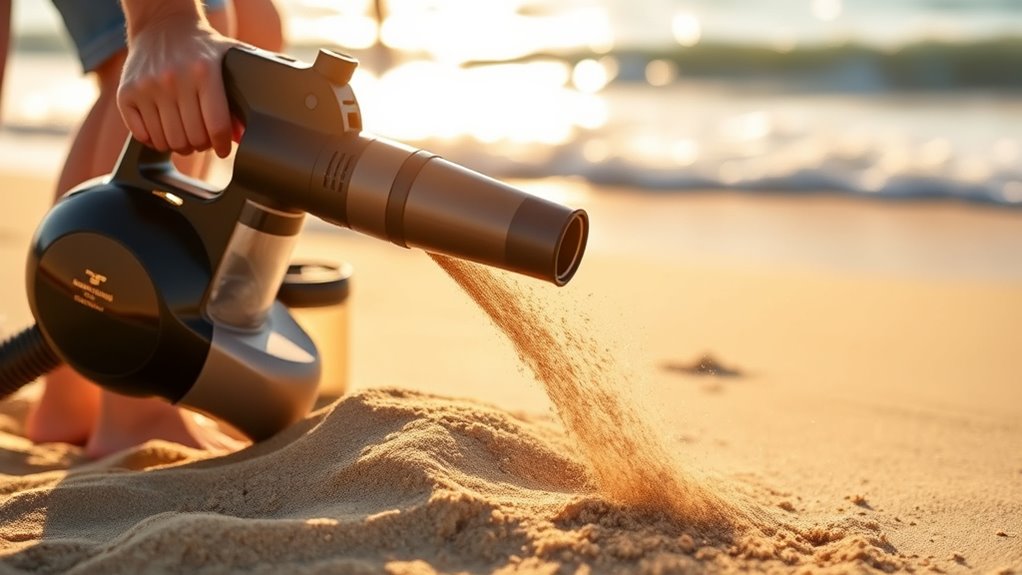
When vacuuming after a beach day, controlling the spread of sand is essential to keep your space clean and minimize mess. Proper sand containment and dust prevention are key. To avoid spreading sand beyond your vacuumed area, consider these tips:
- Use a vacuum with a sealed, HEPA filter to trap dust and prevent airborne particles.
- Vacuum slowly in overlapping passes to contain sand effectively.
- Keep the vacuum’s brush height low to lift sand without dispersing it.
- Seal off adjacent rooms with doors or plastic sheeting to prevent sand from migrating.
- Selecting a projector with high contrast ratio can improve visibility of details during setup, which is useful for creating an optimal home cinema environment.
Implementing these strategies ensures that sand stays contained, dust is minimized, and your cleanup is efficient. Focus on containment techniques to make post-beach cleanup less of a chore.
Post-Vacuum Maintenance for Long-Lasting Performance
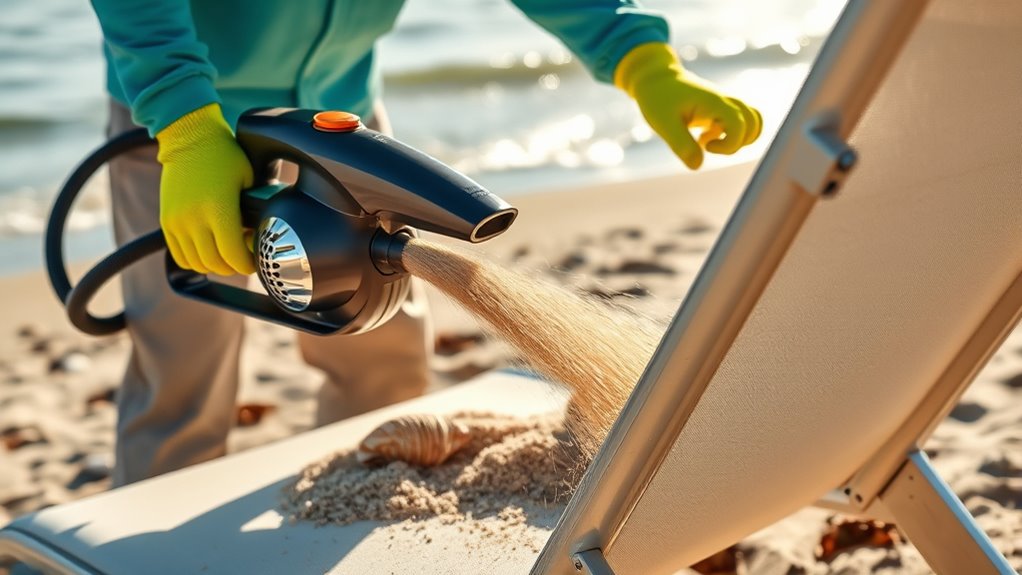
To guarantee your vacuum continues to perform efficiently after a beach cleanup, regular maintenance is essential. Vacuum maintenance involves cleaning the brush roll, emptying the dust bin, and inspecting hoses for sand buildup. One of the most important steps is filter replacement; sandy debris can clog filters, reducing suction power. Replace filters according to the manufacturer’s schedule or sooner if you notice decreased performance. This helps prevent motor strain and prolongs your vacuum’s lifespan. Additionally, check for any damage caused by abrasive sand, such as worn belts or cracked parts. Keeping your vacuum well-maintained ensures it stays powerful and ready for your next cleanup. Regular care minimizes breakdowns and maintains excellent performance, making future beach day cleanups quick and hassle-free.
Frequently Asked Questions
How Often Should I Vacuum My Beach Gear After a Day at the Beach?
You should vacuum your beach gear, like your beach towel, after every beach day to keep it clean and fresh. Regular sand removal techniques prevent sand buildup and make future use easier. For your beach towel maintenance, a quick vacuum or shake helps remove loose sand. If sand persists, use a handheld vacuum or a lint roller to efficiently clear stubborn grains, ensuring your gear stays in great shape and ready for your next adventure.
Can I Use a Regular Home Vacuum for Sand Cleanup?
Did you know that over 70% of homeowners try to use their regular vacuums for sand cleanup? While it might seem convenient, a regular home vacuum isn’t ideal for sand removal, as it can clog and damage the machine. You should check your vacuum maintenance and consider using a hand or shop vac with a brush attachment. These sand removal techniques make cleaning easier and protect your equipment from wear and tear.
What Safety Precautions Should I Take When Vacuuming Sandy Areas?
When vacuuming sandy areas, you should prioritize safety. Always wear protective gear like goggles and gloves to shield your eyes and skin from sand particles. Guarantee electrical safety by using a vacuum with a grounded outlet and avoiding extension cords that may cause tripping or electrical hazards. Keep the vacuum dry and unplug it before cleaning filters or emptying the bin. Taking these precautions helps you clean safely and effectively.
Are There Specific Vacuum Filters Best Suited for Fine Sand?
For fine sand, you’ll want a vacuum with a HEPA or fine particle filter to prevent clogging. Regular filter maintenance is key to keep it working efficiently. Use appropriate vacuum attachments, like a crevice tool or brush, to target sandy areas without spreading dust. These tools help you clean thoroughly while protecting your vacuum’s motor and filter, ensuring consistent performance after each beach day cleanup.
How Do I Store My Vacuum to Prevent Sand Buildup?
Think of your vacuum as a delicate treasure chest; proper storage keeps it in prime condition. To prevent sand buildup, always empty the dustbin or replace the bag after use, and clean the filters regularly. Store it in a dry, cool place away from dust and moisture. Good vacuum maintenance and storage tips guarantee your vacuum stays ready for the next sandy adventure, keeping it powerful and prolonging its lifespan.
Conclusion
After a day at the beach, your vacuum can make cleanup quick and easy. Did you know that a single beach trip can deposit up to 2 pounds of sand into your car and home? By choosing the right vacuum and using proper techniques, you’ll prevent sand from spreading and keep your space spotless. Regular maintenance guarantees it stays effective, so you can enjoy future beach days without the hassle of lingering sand.

